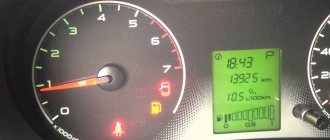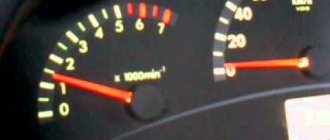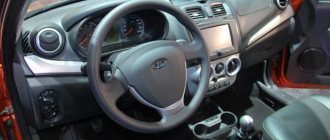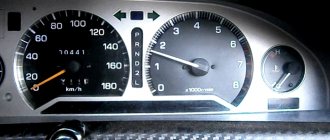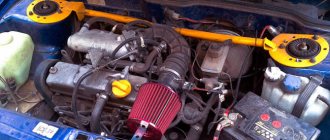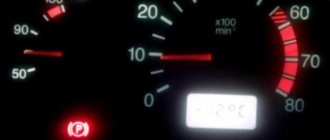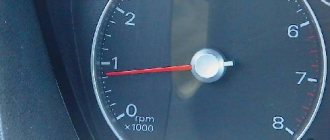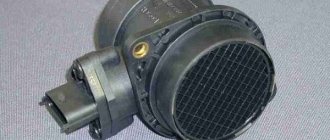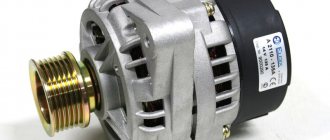After the owners try to start the engine in the morning, sometimes a problem arises: the idle speed of the Lada Granta fluctuates. This is considered one of the most significant shortcomings that arise in VAZ cars. If, after lengthy checks, it is discovered that the cause lies precisely in the throttle assembly, it is necessary to pay special attention to how air leaks through the connections of the intake receiver and the remote control.
First causes of malfunction
The electronic unit, or electronic sensor, is responsible for fuel injection and at the same time calculates the entire volume of air entering the cylinders. In addition, based on the indicators provided by other sensors, the electronic unit opens the injection solenoid valves for a certain time.
The second reason why idle speed fluctuates is constant jamming. It occurs directly in the crankcase ventilation valve. If the malfunction depends on this, the frequency with which the automatic power control sensor operates is disrupted. As a result, the sensor shows instability of engine speed. When in a faulty state, they range from 1,200 to 800 rpm.
It's a disease?
On some copies of the Lada Granta model, even on those that have just recently rolled off the production line, a problem such as floating speed at idle speed of the engine may be observed.
The following two tabs change content below.
- About the expert:
Renault car expert
I own a Renault Megane 2, before that there were Citroens and Peugeots. I work in the service area of a dealership, so I know the car inside and out. You can always contact me for advice.
Elimination of floating speeds
- heads with a ratchet, and their size should be 6 and 8;
- neutral sealant, when purchasing, pay special attention to ensure that it is odorless;
- Silicone Grease;
You need to disconnect and remove the throttle cable stopper from the lever. This work must be done specifically on the throttle assembly. Next you will need to remove the resonator and air pipe. Using TORX T-25 heads and bits that were previously purchased, you need to unscrew the air filter shell. To be able to carry out this work with maximum convenience, you need to remove the wire from the exhaust receiver and all associated fasteners going to the throttle assembly.
Now, having removed the obstacle from the throttle assembly, unscrew all the bolt heads using a ratchet head to do this job. Only after this will it be possible to remove the remote control and remove the rubber rings that serve as a seal at the two ends of the throttle valve. All grooves need to be cleaned as much as possible and the FUM tape should be wound around them in a circle, about 15 times, and on the small pipe - about 10 times.
Only after completing this work can you begin to fully assemble the elements into a single whole. It would also be useful to use a clamp when securing the channel hose and the tube leading to the vacuum booster. This is necessary to further prevent air leaks in the connections.
To check whether the speed on the Lada Granta is floating, look at the IAC sensor. It is located on the throttle body, therefore, in the same place as the sensor responsible for the throttle position. It is secured with two mounting screws. In order to verify its functionality, one multimeter will be enough.
If the vehicle readings are normal, it should be within approximately 80 ohms. In the same case, if the indicators turned out to be significantly higher than the IAC norm, it will be necessary to replace it.
At the moment when the ignition is turned on directly, the rod located on the regulator fully extends and rests against a specially made calibration hole. It is located directly in the throttle pipe. After this, the sensor begins to count steps until the required time and returns the valve to its original state upon completion of operation.
Diagnostic sequence
No specialist can give any precise recommendations on the diagnostic sequence, but if the problem of a suddenly stalling engine appears periodically, you can wait a little and try to determine under what circumstances it occurs. It would also be a good idea to visit specialized forums dedicated to the problems of a particular make and model of car.
And remember that timely maintenance and diagnostics allow you to identify and eliminate possible problems in advance, as well as save your time and money.
Any self-respecting car owner should monitor the health of his car and maintain it in good technical condition. But sometimes there are problems with the startup and operation of the power unit. For example, the engine stalls at idle. What is the reason for this phenomenon, how to deal with it?
Symptoms of floating speed
These symptoms include the widest range from 600 to 1500 rpm.
Main reasons
If similar problems occur on your car, then there may be quite a few reasons for this, but there are only six main ones.
- Idle speed control (IAC) - this part is responsible for stable idle speed. And then when it fails and unstable operation of the revolutions is observed. Since this part is relatively inexpensive, you need to pay attention to it first. It is also worth noting that during intensive use this device may exhibit soot residue from engine operation. ONLY cars in the “STANDARD” version were assembled with this unit!
Throttle assembly without idle speed control (electronic gas pedal)
Engine 21116 (high-voltage wires, oil dipstick)
The role of the mass air flow sensor (MAF)
This device is designed to measure air, a certain amount of which is supplied to the manifold for mixing with gasoline. In appearance, it is a metal mesh and a measuring element placed in it with a four-pin power connector. The measuring element is equipped with a platinum string, which acts as a heat exchanger. It is cooled by the air flow coming from the air filter, and heated by supplying electricity to it; the stronger the air flow, the more electricity is supplied to the platinum.
If the DMVR fails, the electronic unit does not receive a signal about the incoming air volume, and the unit is not able to provide the required engine operating mode.
It is not difficult to check it on a warm engine; to do this, you need to disconnect the power connector from the sensor and start the engine. With this option, the electronic unit will select emergency mode and increase the number of crankshaft revolutions to 1500 per minute. After driving a car for several kilometers and realizing that the car has become much more responsive, you can identify a malfunction of the mass air flow sensor and the need to replace it.
To be more convincing, you can use a tester, switching it to the maximum two-volt constant voltage mode. After that, turning on the ignition in the car, the red wire of the tester is connected to the yellow wire of the mass flow sensor connector, and the black wire to the green. The tester should show a value from 101 to 103, which means that it is working. If above 105, the sensor is faulty and requires replacement.
The cause of failure of this part is most often an excessively clogged air filter and a malfunction of the crankcase ventilation of the power unit.
Difference between carburetor and injection filters
After a mileage of 10 thousand kilometers, it is necessary to change the air filter. It is located in a plastic or metal case (on injection and carburetor engines, respectively). If this element looks like the one in the photo below, it should be replaced.
But not only the air is purified in the system. Pay attention to fuel filters too. On diesel engines they are changed every 15 thousand kilometers. As for cars with gasoline engines, they are serviced once every 50 thousand. The throughput of these elements is 10 microns. If low-quality gasoline or diesel was used, the insides of the filter quickly become clogged. There is porous paper inside.
If there is a large amount of dirt, the element is no longer able to clean the fuel. As a result, the car does not hold idle speed and stalls. Even the fact that the pump operates under high pressure does not help. If the filter is heavily clogged, it must be changed immediately. Signs of replacement are also power losses and dips in dynamics.
Pumps
If the car stalls at idle, the reason may lie in low pump pressure. On injection engines it is submersible and is located in the fuel tank itself. On carburetor engines, this element is located separately from the tank and is of the mechanical type. This pump is driven by a handle.
If the car does not start at all, it is worth checking the power to the element. Look at the fuses and relays. If on an injection engine the pump does not hum when you turn the ignition key, it means there is no power going to it. On passenger cars it is located in the rear of the passenger compartment, on the right (under the passenger sofa). If it is a diesel power unit, it is worth checking the high pressure fuel pump.
conclusions
As you can see, there are quite a lot of reasons for the occurrence of floating speeds, and to find out the final cause of this problem, you can simply diagnose the equipment.
A couple of months ago, dips in engine speed up to 560 rpm began to appear. This happens after the crankshaft speed decreases below 1000 rpm. The main factor in the manifestation of failures was the engine temperature of 80-82 degrees, later failures appeared at 10-15 degrees. In neutral gear, when you sharply press the gas pedal, the speed rises to 1000-1100 rpm, after which it sharply drops to 560 rpm and lower, the voltage drops to 13 volts. When driving, this happens in second gear when changing to first and first gear before coming to a complete stop. In the manual mode of switching from fourth to third, blocking the overdraft, followed by a transition to second and first gears, there are no failures until the speed drops to 1000 rpm and the speed is 8-9 km/h. Acceleration to the floor does not cause the automatic transmission to slip, engine braking is intense without jerks, dips or jerks, the ATP level is normal. The automatic transmission is fine. As soon as the first cold weather arrived, the car, in addition to failures, began to kick in all gears. Visits to diagnosticians, changing firmware for all sorts of tuning, did not give any results. The last diagnostician, like from Motor Master, said that this is a characteristic feature of my car and I need to sew it online for 4000. The only thing that could be done was a sharper pedal. I talked with automatic transmission repair specialists, they said 20,000 for repairing the hydraulic plate, they say it is one hundred percent.
I began to figure out for myself what had been done: 1 — Remove all modifications.
I completely disassembled my crankcase ventilation and ignition modifications. The revs began to fluctuate and the engine growled a little. I returned everything to its place.
2 — Adjusting the throttle valve.
Author of the idea www-shurik. The idea is that the valve in the throttle body is not perfectly centered from the factory and this affects fuel consumption, dynamics and other parameters. If you calibrate the throttle, first removing the air pipe from the throttle and turning on the ignition, you will see how the ECU closes the throttle to the zero position. My throttle did not close completely; there was a small gap. The opening percentage, on pure throttle, at idle in neutral was from 2.8% to 3.6%, flow rate from 1.1 l/h to 1.2 l/h. He removed the throttle, then washed it until it was shiny, removed the gearbox cover, loosened the damper screws, then closed the damper using the gear and carefully tightened the screws. Next, we check, for clearance, the uniformity of the gap of the damper relative to the body. If we put it in place evenly, if it’s not very evenly we try again. The main thing is to twist it carefully and without fanaticism. After adjustment, the opening percentage became 1.0% - 1.1%, the flow rate became 0.86 l/h - 0.96 l/h. And the main bonus was that the roar of the engine at idle went away and it began to run more smoothly.
3 - Firmware
We flashed it for the serial I464AI10, the last one for Grant with automatic transmission. I hoped that the firmware would solve the problem of kicks and failure, but no, everything remained the same. The surprise was that AVTOTAZ sent out information letter 67-2014 to the officials, solving the problem with inadequate operation of the air conditioner on automatic transmissions. Only the officials forgot to talk about this, even though I addressed this problem. I turned on the air conditioner, and it actually worked better, there was less roar from the engine and the engagement of the clutch was better.
What causes the car to jerk when running at low speeds?
Since the car begins to twitch when reaching even low speeds, it will not be possible to immediately identify one specific problem. Problems may be hidden:
- In the engine fuel mixture supply system;
- In the vehicle ignition system;
- At the checkpoint;
- In the distributor design;
- Includes fuel filters;
- In the sparking system;
- In the control unit of the vehicle's on-board computer.
Let's go through the faults in each of the listed systems in detail.
Tip: When detecting a “jerking” behavior in the vehicle, the brakes may also squeak when braking. These 2 problems can be either interrelated or indicate completely different breakdowns.
Checking the engine fuel mixture supply system
Often the reason that the car jerks at low speeds is due to a malfunction of the power system. When the car starts to move, the cylinders simply cannot receive the required amount of fuel mixture, as a result of which the car is unable to transfer the required amount of power to the chassis for smooth driving and smooth commissioning of the transmission. As a result of increased pressure and transmission resistance, uneven running of the machine appears.
Catalytic converters
With the increase in environmental standards, so-called particulate filters began to be installed on diesel cars, and catalysts on gasoline cars. They are designed for a certain service life (about 150 thousand kilometers). Over time, the core becomes clogged. The device cannot produce normal release and purification of exhaust gases.
The way out of this situation is to replace the catalyst with a flame arrester and reflash the electronic unit. But at the same time, the emission standards of your car will drop to Euro-1 values. In the countries of the European Union, the operation of such vehicles is prohibited. But if you drive mainly in the CIS, this is the most optimal solution to the problem. After all, the cost of a new catalyst and particulate filter starts from 40 thousand rubles.
Electronic throttle valve: how does it work and how to repair it?
The trend in automotive engineering in recent years has been the systematic removal of the driver from direct control of the car. So far, thank God, we have not reached the point of losing the rigid connection of our arms and legs with the turning wheels and brakes, but everything is clearly heading that way... At least, not a single car these days is produced without an electronic throttle, with which we We do not give a direct command to the throttle “more air!” with the right foot through the cable, and express a wish to the engine control unit, which itself sends a command to the damper. Is this good or bad, and how to live with it?
Background
It is generally accepted that the so-called E-gas is a technology of the last decade or so. In its pure form - yes, but the integrated electric drive in throttle valves appeared much earlier - back in the 80s. In those years, on the damper axis, on one side there was a gas sector connected to the accelerator pedal with a classic cable (yes, the “wheel” that is driven by a cable from the pedal is called the “gas sector”!), and on the other side, the damper axis connected through a gear transmission to a small electric motor.
Actually, the motor had no influence on the behavior of the car when moving - the connection with the driver’s foot was old-school, mechanical and clear: as you press, so will you go! And the electric motor started working only in idle mode, adjusting the speed of the damper slightly during warming up and after warming up, and also slightly adding gas when turning on powerful consumers of electricity and torque - air conditioning in the summer, power steering in the cold, various heating systems, etc. A little later, the functions of the motor in the throttle expanded - with an almost unchanged design, electronic commands were added: it began to control not only idle speed, but also speed while driving - when the cruise control is turned on and when the traction control system is activated.
Now everything has reached the “apophygea of technology” - the mechanical connection between the damper and the gas pedal has disappeared in principle, and all commands - both from the driver’s foot and from service systems - are received by the throttle only through the mediation of the engine control unit. There are three reasons for this:
- Environmental requirements;
- Increased fuel economy;
- Convenient implementation of many modern car functions.
Electronic throttle these days
So, the direct connection between the throttle valve and the pedal has been completely and completely abolished. As I already said, by pressing the pedal we send a signal to the control unit, which in turn analyzes the situation and many parameters, and then issues a command to supply air. At the same time, it must be said that over a good ten years of development of the tandem of an electronic gas pedal and an electronic throttle in its modern understanding, the system has successfully outgrown a number of childhood diseases - both purely physical and software.
Wearing sliding contacts of damper position sensors have been replaced by non-contact inductive coupling, and many new functions have appeared - not so obvious as to take a line in the technical description of the car, but quite important in the complex.
For example, the gas pedal travel has become non-linear, which makes it possible to better control the car when starting to move: with a powerful engine (where the damper has a large diameter), the risk of excessively rushing forward when lightly touching the pedal has disappeared - the electronic throttle reacts deliberately sluggishly in the first quarter of the gas pedal travel .
E-gas allows for the most optimal acceleration in a car with a turbocharged engine, significantly combating turbo lag and providing smoother acceleration from the bottom. E-gas will also help in the “pedal to the floor” mode, when in the case of a classic cable damper, the first moments of non-optimal combustion of the mixture occur, and seconds are lost during acceleration. Of course, we cannot fail to mention the effective automatic engine traction control system to combat drift and slippage of the drive wheels .
However, it should be noted that the behavior of the electronic throttle on budget cars is still seriously different from mid-price and, especially, premium cars. In “budget” cars, E-gas, unfortunately, is too dull, thoughtful and does not contribute to getting true pleasure from the drive.
Moreover, sometimes it has a negative impact on safety - a throttle with suboptimal control software reacts to pedal pressure with a delay, delivering torque to the wheels when it is already too late. In the absence of stabilization systems in winter on slippery surfaces and when turning, such a car reaction can negate your traditional winter driving skills and create an emergency situation.
The simplicity and complexity of electronic throttle
Typically, the introduction of electronics is accompanied by incredible complication of the design. In the case of the throttle, everything is exactly the opposite! Having carefully studied it, you will find that it is incredibly simple and devoid of a number of tricky technical solutions that were previously available in classic cable-driven chokes. And the good old two-chamber carburetor, compared to the E-choke, is the most complex and expensive device of the steampunk era to produce...
Firstly, of course, the E-throttle does not need an idle air regulator - an air supply valve through a thin channel controlled by a stepper motor, which is prone to contamination by crankcase gases and unstable operation. In the case of an electronic throttle, the idle speed control valve disappears - idle speed is ensured by slightly opening the main damper - after all, it is already electrically controlled, and therefore copes well with adjusting the speed, adapting to the switched on consumers, the temperature of the outside air and antifreeze, etc.
Even the idle system with a classic throttle often included additional bypass air channels that bypassed the damper, which were also very prone to clogging. These channels did not open smoothly, but according to the “on/off” principle, using external electric valves - for example, to compensate for the load on the engine when the air conditioner was turned on. In the electronic throttle, all this also turned out to be unnecessary - compensation for the drop in speed is again done by the throttle valve itself.
Replacing the gas pedal on Grant
The replacement procedure is quite simple and does not require special technical means. In order to dismantle the unit you will need: - A key for 10.
Sequential steps to replace the gas pedal of a Lada Granta:
1. The first step is to remove the negative terminal from the battery. 2. Next, you need to move to the driver’s side of the car. 3. Above the gas pedal, find and disconnect the contact chip that is connected to the sensor connector.
4. After that, take a 10mm wrench and unscrew the three fastening nuts. When there is insufficient internal space, it is most convenient to use a socket wrench.
5. Remove the pedal from the special mounting pins. Reinstallation is carried out in a mirror sequence.
Steering gear
If the steering mechanism is faulty, a similar problem can also occur. If the steering rack has any malfunction, it can create jerks when starting. In this case, the worn parts of the rack are simply replaced, and the problem disappears.
Also, the steering rack tips may have strong play. As a result, during a sharp start or braking, or increase in speed, so-called steering wheel wobble may occur. Bent tie rods result in a sharp jerk of the steering wheel to one side when starting off. This problem requires a quick solution.
Other elements of the steering system, including bushings and silent blocks, can cause the car to knock and jerk when driving. All this applies to the steering mechanism - it can be the reason why, for example, a GAZelle car jerks when starting off. But GAZelle is not the only brand where such breakdowns occur.
Note that problems with the steering mechanism are easier to solve than problems with the automatic transmission. However, the steering mechanism requires urgent repair for the safety of the driver and passengers.
Fuel quality
The use of high-quality gasoline or diesel fuel is the key to long-term engine life and obtaining maximum power indicators from it. But none of the drivers is completely immune from refueling with low-quality fuel, the use of which threatens not only a significant reduction in power indicators, but also the inability to start the engine. Regular use of low-quality gasoline manifests itself in intensive formation of carbon deposits on the cylinders, pistons, catalyst and exhaust manifold, as well as increased wear of the cylinder-piston group.
Description of the problem
In general, there was a terrible downpour, puddles on the roads, and general floods in the yards.
Heavy rain could affect the operation of the car's electronic systems
But we had to go, my wife and daughter were in the shopping center, and the queue for the minibus, according to them, was huge. I am inclined to believe that the minibuses simply stalled (we have old, decrepit Gazelles in our city).
We have one place that is constantly flooded. I look, and there are new Kia Sid floating on the radiator grille in the water, well, I’m taller, I thought that nothing would happen. Here, as luck would have it, the traffic light is still red, and the intersection is straight, only a pedestrian crossing, on which there is no one at all, since it is knee-deep in water. Most people pass it, even on red lights, quietly. And I’ve only been driving for a month, I’m not used to breaking rules yet. Has stopped.
Belt whistled due to water ingress
My Granta is standing there, waiting for the green light, and then the alternator belt started whistling, as if it was slipping. I see the voltage on the on-board computer jumps, from 13 Volts to 11.8, and there is a whistle under the hood. The light turned green and I was off. I started, drove out of the puddle, accelerated a little and the whistle disappeared. The voltage on the on-board computer screen leveled out to 13.6.
Among the current consumers, my headlights were on, the rear window was heated, the tape recorder was working quietly, and the heater was turned on at second speed to blow the windshield.
I got to the shopping center, stopped, and waited for my wife and daughter. The engine begins to vibrate and bleed a little. I went home already on the detour, there are fewer puddles there. I dropped everyone off and decided to go to the garage.
I started the engine, the revolutions jumped to 6000, I was already scared. Then they dropped to 1000, the engine sneezed and died. The check engine light on the dashboard came on. It started again, it idles, but pressing the gas pedal does not respond. I try to start, it idles and doesn’t respond to the pedal at all when driving. So I drove to the garage in second gear, well the 21116 engine is torquey and drives like a tractor.
I repeated the experiment in the garage. I started it up, tried to press the gas pedal, nothing happened, the revs were like a glove, the engine icon was still on.
How I solved the problem of gas pedal failure
- I took a smoke break and decided to remove the terminal from the battery.
- I reset it and waited five minutes. He swore that he forgot the diagnostic adapter at home.
- Reconnected the terminal and started it.
- “Jackie Chan” stopped burning, the engine reacts to the gas pedal with a vigorous increase in speed. The engine really didn’t start at first, it started only the second time.
I left the garage, circled along the pit line, and came back. There were no signs of damage. Now I'm afraid to drive in the rain.
What could it be? Now I’m subconsciously afraid that if I start the engine, my Lada Granta won’t want to go anywhere in rainy weather. How likely is this situation to happen again?
Features of the Lada Granta throttle assembly
The throttle valve is turned by an electric motor through a gearbox. Both are built into the throttle body. When starting and warming up the engine, as well as during idling, the flow of air into the cylinders is regulated by opening the throttle valve. The throttle position is controlled by two sensors built into the throttle body.
The throttle valve opening angle is set by the electronic control unit (ECU) depending on the estimated amount of air that should enter the engine cylinders. This takes into account the operating mode of the engine (starting, warming up, idling, and so on), the temperature of the ambient air and the engine, and the position of the gas pedal.
Control commands are sent to the throttle assembly to the electric motor. At the same time, the ECU monitors the opening angle of the damper and, if necessary, sends appropriate commands to adjust its position. As a result of the fact that the ECU simultaneously regulates the amount of injected fuel and incoming air, the optimal composition of the combustible mixture is maintained in any engine operating mode.
The electric throttle body is sensitive to deposits that may accumulate on its inner surface. The resulting layer of deposits can interfere with the smooth movement of the throttle valve, jamming it (especially at low opening angles). As a result, the engine will operate unstably and even stall at idle, start poorly, and failures may also appear during transient conditions. To avoid this, as a preventive measure, deposits should be removed with special detergent compounds during regular vehicle maintenance. A large layer of deposits can completely block the movement of the damper. If flushing fails to restore the throttle assembly to operability, it must be replaced.
What led to the incorrect operation of the internal combustion engine?
It is sometimes difficult to understand on your own. We recommend contacting a specialized car service center, where experienced technicians will make a correct “diagnosis” of your car and competently fix the problem.
You can evaluate for yourself:
integrity of the intake channel regulator corrugation;
state of the mass air flow sensor (pulling off the plug while the car is running);
degree of contamination of air filters;
At Uremont you will find a convenient car service. In case of the problems described above, you can get to the nearest workshop by constantly pressing the accelerator (change of gas required). An alternative option is to indicate in the application on the aggregator website uremont.com that you need a tow truck. You can easily find out about the price and other details of the repair in a special chat.
